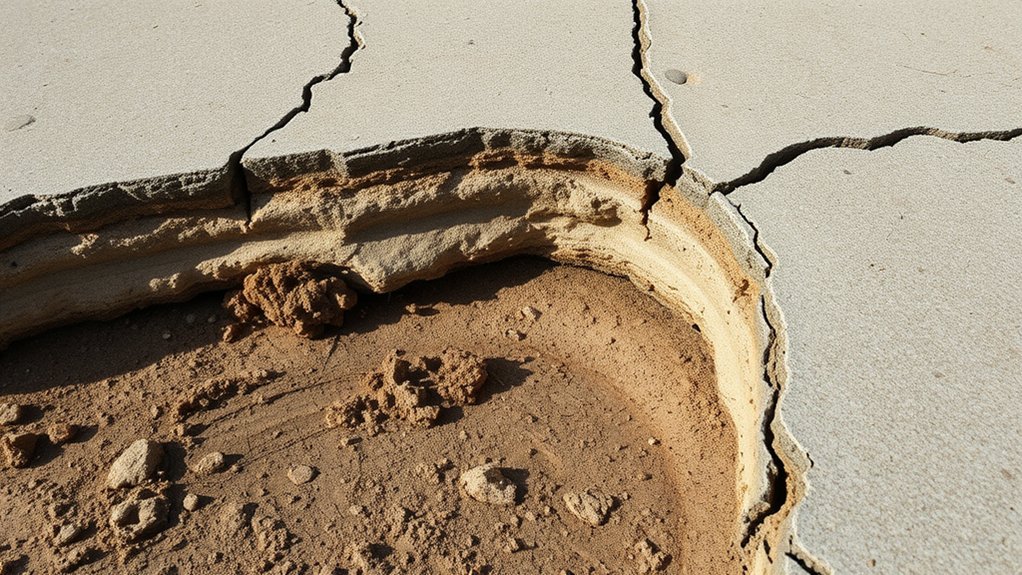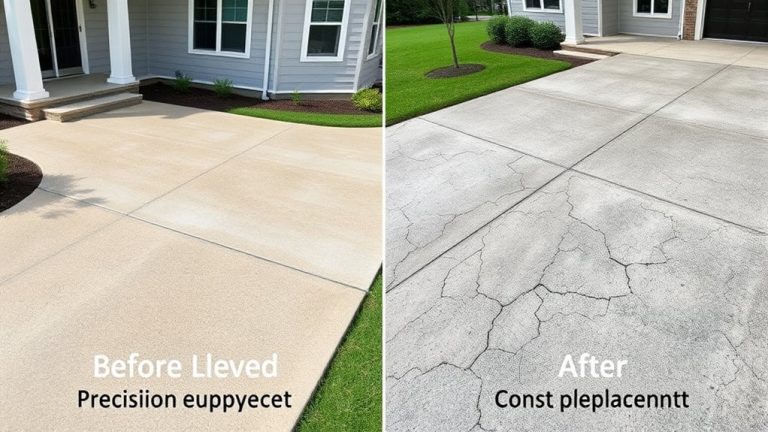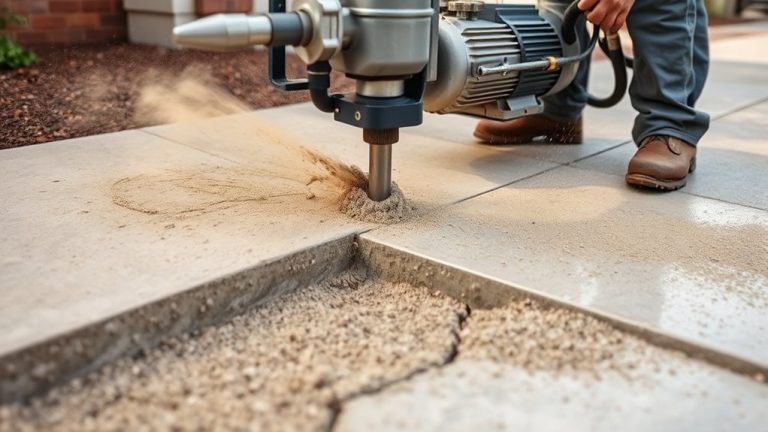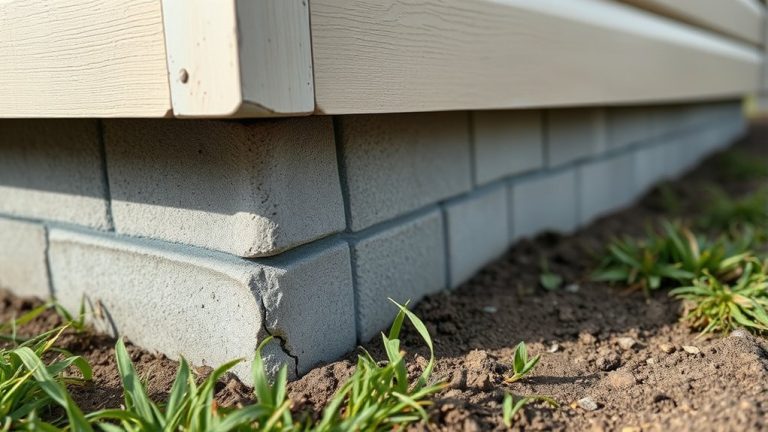Have you noticed your driveway or sidewalk looking uneven or starting to sink? Don't panic. Concrete settlement is a common issue that happens to many homeowners. Various factors like soil conditions, water drainage, and ground movement can cause these unsightly and potentially dangerous surface changes. What's causing your concrete to sink, and how can you prevent further damage? Stay tuned to investigate the hidden reasons behind this structural challenge and discover effective solutions that can save you time and money.
Key Takeaways
- Underlying soil conditions like poor compaction, erosion, and water intrusion can cause concrete surfaces to sink and create uneven, unstable foundations.
- Common warning signs include visible cracks, noticeable dips, water pooling, and gaps forming between concrete and adjacent structural elements.
- Professional repair techniques such as polyurethane foam injection and mudjacking can effectively address concrete settlement by stabilizing and leveling surfaces.
- DIY repairs might save money, but professional interventions provide guaranteed structural integrity and comprehensive solutions addressing root causes of concrete sinking.
- Preventative maintenance strategies like regular inspections, proper drainage, concrete sealing, and prompt issue resolution can minimize future concrete settlement risks.
Common Causes Behind Concrete Settlement
When concrete surfaces start to sink or settle, it's usually due to several underlying factors that homeowners should understand. Soil erosion and water intrusion are primary culprits behind concrete settlement. Failing support systems in crawl spaces and foundations can significantly contribute to this gradual sinking process. Poor drainage, unstable ground conditions, and inadequate soil compaction can cause your driveway or sidewalk to gradually sink. These issues often develop slowly, creating uneven surfaces that can become safety hazards. Shifting soil beneath concrete, combined with water penetration, weakens the foundation and leads to unexpected settling. Understanding these causes helps you take proactive steps to protect your property's structural integrity and prevent further damage.
Warning Signs of Sinking Concrete
Because concrete surfaces often deteriorate gradually, spotting early warning signs can save you significant repair costs and prevent potential safety risks. Watch for these critical indicators of concrete settlement:
- Uneven surfaces with noticeable dips or slopes
- Visible cracks in concrete spreading across your driveway
- Sections of concrete that appear lower than surrounding areas
- Water pooling instead of draining properly
- Gaps forming between concrete and adjacent structures
These signs suggest underlying soil movement or erosion that could compromise your concrete's structural integrity. Ignoring them might lead to more extensive and expensive repairs down the road. Consulting foundation repair experts can help diagnose and address these issues before they become critical structural problems.
Professional Repair Techniques and Solutions
Recognizing the warning signs of a sinking driveway or sidewalk sets the stage for understanding professional repair solutions that can restore your concrete's stability and appearance. Professionals offer several structural reinforcement options to address concrete settling, including polyurethane foam injection and expert mudjacking techniques.
These cost-effective resurfacing methods can quickly level uneven surfaces without complete replacement. You'll want to choose a solution that addresses underlying soil issues, provides long-term stability, and minimizes future damage. Experienced contractors can assess your specific situation and recommend the most appropriate repair strategy for your property's unique needs.
Cost Analysis: DIY vs. Professional Repairs
Although sinking driveways and sidewalks might seem like a minor issue, the repair costs can quickly escalate depending on your chosen approach. Consider these affordable material options and long-term cost considerations:
- DIY repairs can save 50-70% compared to professional services
- Professional techniques offer guaranteed structural integrity
- Material costs range from $50 to $500 depending on damage extent
Complex repairs might require specialized equipment. Labor costs for professionals typically range $500-$2,000.
Your choice depends on skill level, time availability, and budget. While DIY might seem cheaper initially, professional repairs often provide more reliable, lasting solutions that prevent future structural complications and potential expensive replacements.
Preventative Maintenance Strategies for Concrete Surfaces
Protecting your concrete surfaces from future damage starts with proactive care and smart maintenance strategies. By maintaining concrete integrity, you'll prevent costly repairs and extend your driveway's lifespan.
Regularly inspect your surfaces for small cracks, uneven areas, or drainage problems that could lead to sinking. Monitor concrete condition by checking for water pooling, soil erosion, or signs of settling.
Seal your concrete every few years, guarantee proper drainage around the area, and address minor issues quickly. These simple steps can save you significant time and money in the long run.
Frequently Asked Questions
Can Sinking Concrete Lead to Serious Structural Damage to My Home?
You'll face potential foundation cracks if erosion beneath concrete goes unchecked, risking serious structural damage that threatens your home's integrity and your freedom to live securely.
How Quickly Does a Concrete Settlement Problem Become Worse Over Time?
If you don't address soil erosion rate and groundwater fluctuations quickly, concrete settlement can worsen exponentially within months, potentially compromising your property's structural integrity and freedom to use your space.
Will My Homeowner's Insurance Cover Concrete Repair or Replacement Costs?
Your insurance policy may not cover concrete repairs unless damage results from a specific covered event. Check your policy's deductible amount and exclusions for potential limitations on structural settlement repairs.
Are There Environmental Factors That Increase the Risk of Concrete Sinking?
You'll face higher concrete sinking risks when soil moisture content varies dramatically and water table fluctuations destabilize your ground, potentially compromising your property's structural integrity and your freedom to maintain stable surfaces.
Can I Temporarily Stabilize a Sinking Driveway Before Professional Repairs?
You can use temporary patch repairs like sand-cement mixtures or polyurethane foam for quick concrete leveling methods, stabilizing the surface until professional intervention addresses the underlying structural issues.



